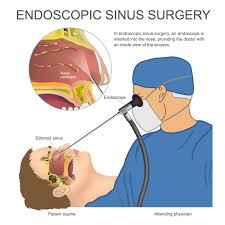 Endoscopic sinus surgery, is a procedure that is used to treat sinusitis and other conditions that affect the sinuses.
Endoscopic sinus surgery, is a procedure that is used to treat sinusitis and other conditions that affect the sinuses.
Functional endoscopic sinus surgery is most commonly used to treat chronic rhinosinusitis (CRS), only after all non-surgical treatment options such as antibiotics, topical nasal corticosteroids, and nasal lavage with saline solutions have been exhausted.
Sinusitis is an inflammation of the sinuses that can cause symptoms such as congestion, headaches, and difficulty breathing through the nose.
Endoscopic sinus surgery is a minimally invasive procedure that is performed using an endoscope, with a camera on the end.
The endoscope is inserted through the nostrils, allowing the surgeon to visualize the inside of the nasal passages and sinuses.
It allows the surgeon to remove any tissue or obstruction that is blocking the sinuses, such as swollen or infected tissue.
Endoscopic sinus surgery is considered to be a safe and effective treatment for sinusitis and other conditions that affect the sinuses, and helps to alleviate symptoms and improve the overall functioning of the sinuses.
Chronic rhinosinusitis (CRS), is an inflammatory condition in which the nose and at least one sinus become swollen and interfere with mucus drainage.
Chronic rhinosinusitis (CRS), can be caused by anatomical factors such as a deviated septum or nasal polyps, as well as infection.
Chronic rhinosinusitis (CRS), symptoms include: difficulty breathing through the nose, swelling and pain around the nose and eyes, postnasal drainage down the throat, and difficulty sleeping.
CRS is a common condition in children and young adults.
The purpose of endoscopic sinus surgery in treatment of CRS is to remove any anatomical obstructions that prevent proper mucosal drainage.
Endoscopic sinus surgery includes removal of the uncinate process, and opening of the ethmoid air cells and Haller cells as well as the maxillary ostium, if necessary.
Obstructing nasal polyps that impair ventilation or drainage can be removed.
In the case of paranasal sinus/nasal cavity tumors, benign or cancerous, endoscopic sinus surgery can be performed to remove the growths.
In Graves’ ophthalmopathy, inflammation and fat accumulation in the orbitonasal region can cause severe proptosis and can endoscopic sinus surgery can be used to decompress the orbital region by removing the ethmoid air cells and lamina papyracea.
The endoscopic approach is a less invasive method than open sinus surgery, which allows patients to be more comfortable during and after the procedure.
Entering the surgical field via the nose, decreases risk of damaging nerves which innervate the teeth.
Modification of the nozzle of the nasal spray allows for better delivery of local therapeutic agents into the ethmoid sinuses.
Endoscopic Sinus Surgery is considered a success if most of the symptoms, including nasal obstruction, sleep quality, olfaction and facial pain, are resolved after a 1-2 month postoperative healing period.
Endoscopic sinus surgery treatment for chronic rhinosinusitis has shown that a majority of patients report increased quality of life after undergoing surgery.
success rate in treating adults with CRS has been reported as 80-90%, and the success rate in treating children with CRS has been reported as 86-97%.
The most common complication of endoscopic sinus surgery is cerebrospinal fluid leak which has been observed in about 0.2% of patients.
If cerebrospinal fluid leak arises during surgery it can be repaired with no additional related complications postoperatively.
Other risks of endoscopic sinus surgery include infection, bleeding, double vision usually lasting a few hours, numbness of the front teeth, orbital hematoma, decreased sense of smell, blindness, and the medial rectus muscle may be damaged.
Blindness is the single most serious complication. resulting from damage to the optic nerve during surgery: 0.44% of cases.
A Cochrane review based on three randomized control trials concluded that endoscopic sinus surgery has not been shown to provide significantly better results than medical treatment for chronic rhinosinusitis.
Another Cochrane review found removal of blood clots, crusts, and secretions from the nasal and sinus cavities under local anaesthetic, but the evidence of benefit from the available clinical trials was uncertain.
Functional sinus surgery had been grossly overutilized as a way of treating headache based on an assumption of a sinus etiology of the different types of primary headache.
